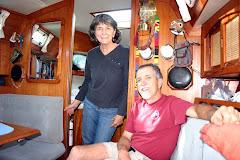However, this next passage turned out to be a completely different ball game. We had perfect tradewind sailing along our westward track, with very light sea conditions due to being in the lee of New Caledonia. Southern Cross logged a couple of 150-mile days, and before we knew it, we were approaching the "Grand Passage" between the Pacific and the Coral Sea. Strong upwellings and currents in the pass were revealed by a frenzy of seabirds feasting on vast schools of fish.

Ed's father was sending us nightly weather forecasts from his boat anchored in the Baltic; with a favorable forecast, we planned a stop at the Chesterfield Reef, a vast uninhabited archipelago of tiny cays, administered by New Caledonia. I had tried to get official permission to stop here, but the Maritime Affairs department never replied to my emails, and the French Consul in Port Vila was no help. We decided it was worth the small risk of being fined or booted out.

We had several waypoints (thanks to Evan and Diane on Ceilydh) for approaching and anchoring in the lagoon, but other than that, our Navionics chart was sorely lacking in detail. As we neared the approach waypoint for the lagoon, the wind picked up to a steady 20 knots. It was 1330, meaning we had about 4 hours to get the boat safely anchored, or else face darkness in a poorly-charted area full of reefs! Visibility was good, so I tried to "cut the corner" from the approach waypoint toward the anchorage. But when soundings steadily decreased, and large bommies started appearing, we doubled back to the north, adding another two miles to the distance we had to cover to get to the anchorage. By the time we were back in deep water inside the lagoon, the anchorage was dead to windward, with a short two-foot chop reducing our speed to about 3 knots. The clock was ticking, so we tried tacking with a small bit of jib rolled out and the engine running. Slowly we made our way to the south. I told Ed that if we weren't in sight of the anchorage in another half-hour, we would have to turn and run for the passage through the west side of the reef and back out to sea.
Shortly thereafter, we spotted a ketch to the south. At first I thought she was also motoring toward the anchorage, but when we hailed her on VHF, we learned that Quintessa was anchored in the middle of the lagoon, in over 30 meters of water! Thus reassured that conditions were better ahead of us, we carried on, and reached a nice sand patch in the lee of the eastern string of cays, with an hour of daylight to spare. The Rocna hooked immediately, as usual, and I went below to warm up and get some food. Ed, not one to rely on unfamiliar ground tackle, stayed on anchor watch a while longer, while I tried to convince him of my anchor's dependability.

The next morning, the wind continued to blow a steady 20 knots and higher, ensuring that a trip to shore would be somewhat like getting wet-sanded. We stayed on the boat until mid-afternoon, when we were invited over to Quintessa for a beer. She turned out to be a powerful 65-foot ketch, hailing from Whangarei, NZ; her skipper Allen turned out to be a rather obsessive shell collector. He had been singlehanding among the reefs in the Coral Sea for several weeks, seeking out remote bommies where he would dive alone, at night, in shark-infested waters, in search of Conus lamberti and other rare (and often extremely venomous) molluscs. Talk about commitment!

The next morning, the sky was filled with a glorious and bloody sunrise, and the wind had abated to about 15 knots.
Before we knew what was happening, a pair of humpback whales came right past the boat. If we'd had our wits about us, we could have jumped right in and swam with them. After grabbing our masks and fins, we got into the dinghy and spent the next hour following them along the fringe of the lagoon. Ed caught a brief glimpse of them underwater, but they were swimming too quickly to keep up with.
After giving up our pursuit of the whales, we dinghied ashore, trying not to disturb the nesting boobies, frigatebirds, noddies, and terns.
That afternoon, a third boat, TryBooking (named for its owner's company) anchored nearby. A group of Melbourne sailors were delivering her back home from the Vanuatu race, and they told us there was a good weather window approaching, so we made plans to head out the next morning. Glad we were able to stop here at Chesterfield. It is good to know there are still such places where wild nature can flourish relatively unmolested.














1 comment:
I heard you are selling your boat, is that right?
Where is she in Australia
Post a Comment